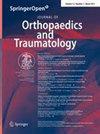Polytherapy versus monotherapy in the treatment of tibial non-unions: a retrospective study
IF 3.7
2区 医学
Q1 ORTHOPEDICS
引用次数: 0
Abstract
Treating tibial non-unions efficiently presents a challenge for orthopaedic trauma surgeons. The established gold standard involves implanting autologous bone graft with adequate fixation, but the addition of biologicals according to the so-called diamond concept has become increasingly popular in the treatment of non-unions. Previous studies have indicated that polytherapy, which involves implanting mesenchymal stem cells, bioactive factors and osteoconductive scaffolds, can improve bone healing. This study aims to evaluate the efficacy of polytherapy compared with monotherapy in treating tibial non-unions of varying severity. Data from consecutive tibial non-unions treated between November 2014 and July 2023 were retrospectively analysed. The Non Union Scoring System (NUSS) score before non-union surgery, and the Radiographic Union Score for Tibial fractures (RUST), scored at 1, 3, 6, 9, 12 and 18 months post-surgery, were recorded. Initially, a comparison was made between the polytherapy and monotherapy groups. Subsequently, patients receiving additional surgical non-union treatment were documented, and the frequency of these treatments was tallied for a subsequent per-treatment analysis. A total of 34 patients were included and divided into a polytherapy group (n = 15) and a monotherapy group (n = 19). The polytherapy group demonstrated a higher NUSS score (44 (39, 52) versus 32 (29, 43), P = 0.019, z = −2.347) and a tendency towards a higher success rate (93% versus 68%, P = 0.104) compared with the monotherapy group. For the per-treatment analysis, 44 treatments were divided into the polytherapy per-treatment group (n = 20) and the monotherapy per-treatment group (n = 24). The polytherapy per-treatment group exhibited a higher NUSS score (48 (43, 60) versus 38 (30, 50), P = 0.030, z = −2.173) and a higher success rate (95% versus 58%, P = 0.006) than the monotherapy per-treatment group. Within the monotherapy per-treatment group, the NUSS score displayed excellent predictive performance (AUC = 0.9143). Setting the threshold value at 48, the sensitivity and specificity were 100.0% and 70.0%, respectively. Polytherapy is more effective than monotherapy for severe tibial non-unions, offering a higher success ratio. The NUSS score supports decision-making in treating tibial non-unions. Level III.治疗胫骨非整复的综合疗法与单一疗法:一项回顾性研究
如何有效治疗胫骨非塌陷是创伤骨科医生面临的一项挑战。既定的金标准包括植入自体骨移植并进行适当固定,但根据所谓的钻石概念添加生物制剂在治疗非胫骨髁内翻方面越来越受欢迎。以往的研究表明,多疗法(包括植入间充质干细胞、生物活性因子和骨诱导支架)可改善骨愈合。本研究旨在评估多元疗法与单一疗法相比,在治疗不同严重程度的胫骨非塌陷方面的疗效。研究人员回顾性分析了2014年11月至2023年7月期间连续接受治疗的胫骨非联合患者的数据。记录了不愈合手术前的不愈合评分系统(NUSS)评分,以及手术后1、3、6、9、12和18个月的胫骨骨折放射学愈合评分(RUST)。最初,对多疗法组和单一疗法组进行了比较。随后,记录了接受额外手术治疗的患者,并统计了这些治疗的频率,以便进行后续的每次治疗分析。共纳入了 34 名患者,并将其分为多种疗法组(15 人)和单一疗法组(19 人)。与单药治疗组相比,多药治疗组的 NUSS 评分更高(44(39,52)分对 32(29,43)分,P = 0.019,z = -2.347),成功率也更高(93% 对 68%,P = 0.104)。在每次治疗的分析中,44 次治疗被分为每次治疗的多疗法组(n = 20)和每次治疗的单疗法组(n = 24)。与单疗法治疗组相比,多疗法治疗组的 NUSS 评分更高(48 分(43,60)对 38 分(30,50),P = 0.030,z = -2.173),成功率更高(95% 对 58%,P = 0.006)。在单药治疗组中,NUSS 评分显示出极佳的预测性能(AUC = 0.9143)。将临界值设定为 48,灵敏度和特异度分别为 100.0% 和 70.0%。对于严重的胫骨骨不连,联合疗法比单一疗法更有效,成功率更高。NUSS 评分可为治疗胫骨非整复提供决策支持。三级
本文章由计算机程序翻译,如有差异,请以英文原文为准。
求助全文
约1分钟内获得全文
求助全文
来源期刊

Journal of Orthopaedics and Traumatology
Medicine-Orthopedics and Sports Medicine
CiteScore
4.30
自引率
0.00%
发文量
56
审稿时长
13 weeks
期刊介绍:
The Journal of Orthopaedics and Traumatology, the official open access peer-reviewed journal of the Italian Society of Orthopaedics and Traumatology, publishes original papers reporting basic or clinical research in the field of orthopaedic and traumatologic surgery, as well as systematic reviews, brief communications, case reports and letters to the Editor. Narrative instructional reviews and commentaries to original articles may be commissioned by Editors from eminent colleagues. The Journal of Orthopaedics and Traumatology aims to be an international forum for the communication and exchange of ideas concerning the various aspects of orthopaedics and musculoskeletal trauma.
 求助内容:
求助内容: 应助结果提醒方式:
应助结果提醒方式:


